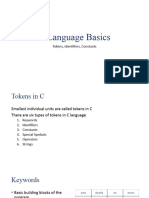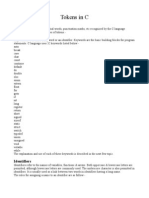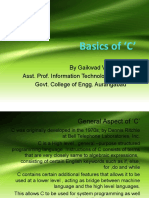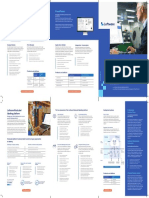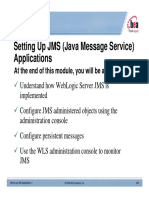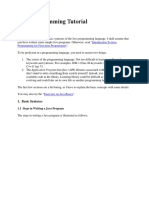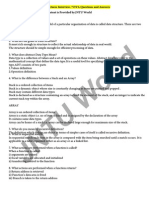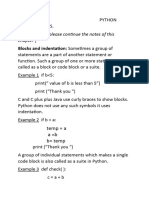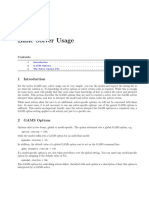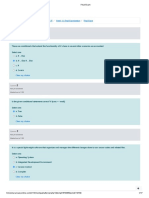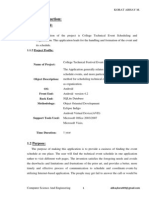4/23/25, 11:22 AM Tokens in C | GeeksforGeeks
Search...
C C Basics C Data Types C Operators C Input and Output C Control Flow C Functions C Arr
Tokens in C
Last Updated : 21 Jan, 2025
In C programming, tokens are the smallest units in a program that have
meaningful representations. Tokens are the building blocks of a C
program, and they are recognized by the C compiler to form valid
expressions and statements. Tokens can be classified into various
categories, each with specific roles in the program.
Types of Tokens in C
The tokens of C language can be classified into six types based on the
functions they are used to perform. The types of C tokens are as
follows:
Table of Content
Punctuators
Keywords
Strings
Operators
Identifiers
Constants
1. Punctuators
https://www.geeksforgeeks.org/tokens-in-c/ 1/11
�4/23/25, 11:22 AM Tokens in C | GeeksforGeeks
The following special symbols are used in C having some special
meaning and thus, cannot be used for some other purpose. Some of
these are listed below:
Brackets[]: Opening and closing brackets are used as array element
references. These indicate single and multidimensional subscripts.
Parentheses(): These special symbols are used to indicate function
calls and function parameters.
Braces{}: These opening and ending curly braces mark the start and
end of a block of code containing more than one executable
statement.
Comma (, ): It is used to separate more than one statement like for
separating parameters in function calls.
Colon(:): It is an operator that essentially invokes something called
an initialization list.
Semicolon(;): It is known as a statement terminator. It indicates the
end of one logical entity. That’s why each individual statement must
be ended with a semicolon.
Asterisk (*): It is used to create a pointer variable and for the
multiplication of variables.
Assignment operator(=): It is used to assign values and for logical
operation validation.
Pre-processor (#): The preprocessor is a macro processor that is
used automatically by the compiler to transform your program before
actual compilation.
Period (.): Used to access members of a structure or union.
Tilde(~): Bitwise One’s Complement Operator.
Example:
#include <stdio.h>
int main() {
// '\n' is a special symbol that
// represents a newline
printf("Hello, World!\n");
return 0;
}
https://www.geeksforgeeks.org/tokens-in-c/ 2/11
�4/23/25, 11:22 AM Tokens in C | GeeksforGeeks
Output
Hello, World!
2. Keywords
Keywords are reserved words that have predefined meanings in C.
These cannot be used as identifiers (variable names, function names,
etc.). Keywords define the structure and behavior of the program C
language supports 32 keywords some of them are:
int, for, if, else, while, return, etc.
Example:
#include <stdio.h>
int main() {
// 'int' is a keyword used to define
// variable type
int x = 5;
printf("%d", x);
// 'return' is a keyword used to exit
// main function
return 0;
}
Output
Note: The number of keywords may change depending on the
version of C you are using. For example, keywords present in ANSI
C are 32 while in C11, it was increased to 44. Moreover, in the
latest c23, it is increased to around 54.
3. Strings
Strings are nothing but an array of characters ended with a null
character (‘\0’). This null character indicates the end of the string.
https://www.geeksforgeeks.org/tokens-in-c/ 3/11
�4/23/25, 11:22 AM Tokens in C | GeeksforGeeks
Strings are always enclosed in double quotes. Whereas a character is
enclosed in single quotes in C and C++.
Examples:
#include <stdio.h>
int main() {
// "Hello, World!" is a string literal
char str[] = "Hello, World!";
printf("%s", str);
return 0;
}
Output
Hello, World!
4. Operators
Operators are symbols that trigger an action when applied to C
variables and other objects. The data items on which operators act are
called operands.
Depending on the number of operands that an operator can act upon,
operators can be classified as follows:
Unary Operators: Those operators that require only a single operand
to act upon are known as unary operators.For Example increment
and decrement operators
Binary Operators: Those operators that require two operands to act
upon are called binary operators. Binary operators can further are
classified into:
1. Arithmetic operators
2. Relational Operators
3. Logical Operators
4. Assignment Operators
5. Bitwise Operator
Ternary Operator: The operator that requires three operands to act
upon is called the ternary operator. Conditional Operator(?) is also
called the ternary operator.
https://www.geeksforgeeks.org/tokens-in-c/ 4/11
�4/23/25, 11:22 AM Tokens in C | GeeksforGeeks
Example:
#include <stdio.h>
int main() {
int a = 10, b = 5;
// '+' is an arithmetic operator used
// for addition
int sum = a + b;
printf("%d", sum);
return 0;
}
Output
15
5. Identifiers
Identifiers are names given to variables, functions, arrays, and other
user-defined items. They must begin with a letter (a-z, A-Z) or an
underscore (_) and can be followed by letters, digits (0-9), and
underscores.
Example:
#include <stdio.h>
int main() {
// 'num' is an identifier used to name
// a variable
int num = 10;
printf("%d", num);
return 0;
}
Output
10
6. Constants
Constants are fixed values used in a C program. These values do not
change during the execution of the program. Constants can be integers,
floating-point numbers, characters, or strings.
Examples:
https://www.geeksforgeeks.org/tokens-in-c/ 5/11
�4/23/25, 11:22 AM Tokens in C | GeeksforGeeks
#include <stdio.h>
int main() {
// 'MAX_VALUE' is a constant that holds
// a fixed value
const int MAX_VALUE = 100;
printf("%d", MAX_VALUE);
return 0;
}
Output
100
Comment More info
Next Article
Placement Training Program Keywords in C
Similar Reads
https://www.geeksforgeeks.org/tokens-in-c/ 6/11








